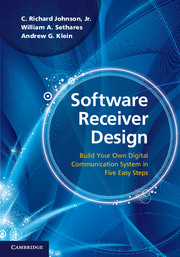Book contents
- Frontmatter
- To the Instructor …
- Contents
- Dedication
- Step 1 The Big Picture
- Step 2 The Basic Components
- Step 3 The Idealized System
- Step 4 The Adaptive Components
- 10 Carrier Recovery
- 11 Pulse Shaping and Receive Filtering
- 12 Timing Recovery
- 13 Linear Equalization
- 14 Coding
- Step 5 Putting It All Together
- Appendices
- Index
- References
10 - Carrier Recovery
from Step 4 - The Adaptive Components
Published online by Cambridge University Press: 05 June 2012
- Frontmatter
- To the Instructor …
- Contents
- Dedication
- Step 1 The Big Picture
- Step 2 The Basic Components
- Step 3 The Idealized System
- Step 4 The Adaptive Components
- 10 Carrier Recovery
- 11 Pulse Shaping and Receive Filtering
- 12 Timing Recovery
- 13 Linear Equalization
- 14 Coding
- Step 5 Putting It All Together
- Appendices
- Index
- References
Summary
Figure 10.1 shows a generic transmitter and receiver pair that emphasizes the modulation and corresponding demodulation. Even assuming that the transmission path is ideal (as in Figure 10.1), the signal that arrives at the receiver is a complicated analog waveform that must be downconverted and sampled before the message can be recovered. For the demodulation to be successful, the receiver must be able to figure out both the frequency and the phase of the modulating sinusoid used in the transmitter, as was shown in (5.4) and (5.5) and graphically illustrated in Figures 9.18 and 9.19. This chapter discusses a variety of strategies that can be used to estimate the phase and frequency of the carrier and to fix the gain problem (of (5.4) and Figure 9.18) and the problem of vanishing amplitudes (in (5.5) and Figure 9.19). This process of estimating the frequency and phase of the carrier is called carrier recovery.
Figure 10.1 shows two downconversion steps: one analog and one digital. In a purely analog system, no sampler or digital downconversion would be needed. The problem is that accurate analog downconversion requires highly precise analog components, which can be expensive. In a purely digital receiver, the sampler would directly digitize the received signal, and no analog downconversion would be required. The problem is that sampling this fast can be prohibitively expensive. The happy compromise is to use an inexpensive analog downconverter to translate to some lower intermediate frequency, at which it is possible to sample cheaply enough.
- Type
- Chapter
- Information
- Software Receiver DesignBuild your Own Digital Communication System in Five Easy Steps, pp. 192 - 225Publisher: Cambridge University PressPrint publication year: 2011
References
- 1
- Cited by



